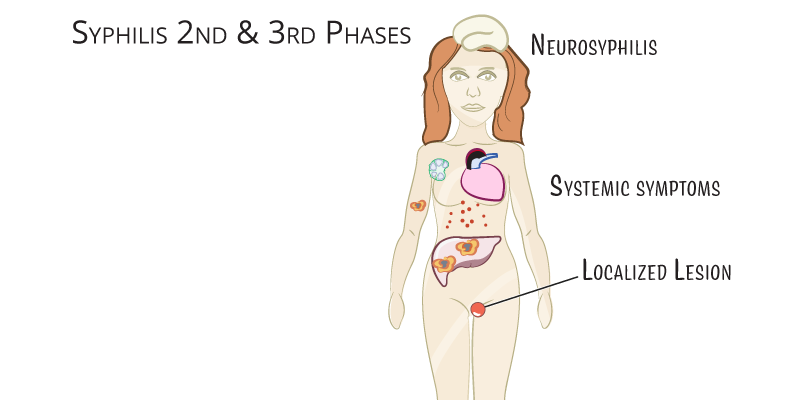Chlamydia, Gonorrhea, Syphilis for USMLE Step 2
Chlamydia, Gonorrhea, Syphilis for the USMLE Step 2 Exam

Chlamydia
- Etiology:
- Caused by Chlamydia trachomatis, an obligate intracellular bacterium. Serotypes D–K are responsible for most urogenital infections.
- Epidemiology:
- The most common bacterial sexually transmitted infection (STI) in the U.S., particularly affecting young adults (ages 15–24).
- Clinical Presentation:
- Men: Commonly asymptomatic but may present with urethritis (dysuria, mucoid or clear discharge).
- Women: Often asymptomatic; symptomatic cases include cervicitis (mucopurulent discharge, friable cervix) and urethritis. Complications include pelvic inflammatory disease (PID), which can lead to chronic pelvic pain, ectopic pregnancy, and infertility if untreated.
- Diagnosis:
- Nucleic Acid Amplification Test (NAAT): Gold standard for diagnosing C. trachomatis, can be performed on urine or swab samples from the urogenital tract.
- Treatment:
- Doxycycline 100 mg twice daily for 7 days or Azithromycin 1 g single dose.
- Partner treatment is essential to prevent reinfection.
Gonorrhea
- Etiology:
- Caused by Neisseria gonorrhoeae, a gram-negative diplococcus.
- Epidemiology:
- High incidence in adolescents and young adults; co-infection with chlamydia is common.
- Clinical Presentation:
- Men: Often present with urethritis (dysuria, purulent discharge), which can progress to epididymitis if untreated.
- Women: Frequently asymptomatic; symptoms may include cervicitis (purulent discharge), PID, and urethritis.
- Extragenital Manifestations: Rectal and pharyngeal infections from anal or oral sex; neonatal conjunctivitis from vertical transmission.
- Disseminated Gonococcal Infection (DGI): Bacteremia with dermatitis-arthritis syndrome, presenting as tenosynovitis, migratory polyarthritis, and septic arthritis.
- Diagnosis:
- NAAT: Preferred for diagnosing N. gonorrhoeae from urine or swabs.
- Gram Stain: Useful in symptomatic men, showing gram-negative intracellular diplococci.
- Treatment:
- Ceftriaxone 500 mg IM single dose; if chlamydia is co-infected, add doxycycline 100 mg twice daily for 7 days.
- Treating sexual partners is essential to prevent reinfection.
Syphilis
- Etiology:
- Caused by Treponema pallidum, a spirochete bacterium.
- Clinical Stages:
- Primary Syphilis:
- Presents ~3 weeks after infection with a painless chancre (ulcer) at the site of inoculation, typically genital, which heals within weeks.
- Secondary Syphilis:
- Occurs weeks to months later, with systemic symptoms such as maculopapular rash (often involving palms and soles), condylomata lata (anogenital wart-like lesions), and mucous patches.
- Latent Syphilis:
- Asymptomatic phase following secondary syphilis, subdivided into early latent (within 1 year of infection) and late latent (>1 year).
- Tertiary Syphilis:
- May develop years later with complications such as cardiovascular syphilis (e.g., aortitis), neurosyphilis (Tabes dorsalis, general paresis), and gummatous syphilis with soft tissue lesions.

- Diagnosis:
- Nontreponemal Tests: Rapid plasma reagin (RPR) or venereal disease research laboratory (VDRL) test; used for screening and monitoring treatment response.
- Treponemal Tests: Confirmatory tests, such as fluorescent treponemal antibody absorption (FTA-ABS) or T. pallidum particle agglutination (TPPA), which remain positive for life.
- Treatment:
- Primary, Secondary, and Early Latent Syphilis: Benzathine penicillin G 2.4 million units IM single dose.
- Late Latent and Tertiary Syphilis (without neurosyphilis): Benzathine penicillin G 2.4 million units IM weekly for 3 weeks.
- Neurosyphilis: Aqueous crystalline penicillin G 18–24 million units per day IV for 10–14 days.
- Alternative treatments for penicillin-allergic patients include doxycycline; however, desensitization is recommended for neurosyphilis.
Key Points
- Chlamydia:
- Caused by Chlamydia trachomatis, often asymptomatic, especially in women.
- Leads to PID, ectopic pregnancy, and infertility if untreated.
- Diagnosed by NAAT, treated with doxycycline or azithromycin.
- Partner treatment is essential to prevent reinfection.
- Gonorrhea:
- Caused by Neisseria gonorrhoeae, often co-infects with chlamydia.
- Presents with urethritis in men and often asymptomatic in women.
- Diagnosed by NAAT and treated with ceftriaxone; add doxycycline if chlamydia is co-infected.
- Sexual partner treatment is necessary to prevent reinfection.
- Syphilis:
- Caused by Treponema pallidum, with stages: primary (chancre), secondary (rash, systemic), latent, and tertiary (cardiovascular and neurosyphilis).
- Diagnosed with nontreponemal and treponemal tests.
- Treated with penicillin, with follow-up serology and partner treatment to control transmission.
